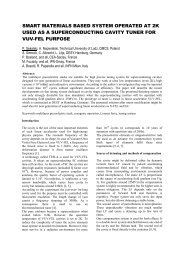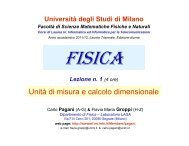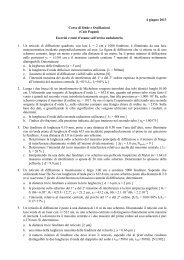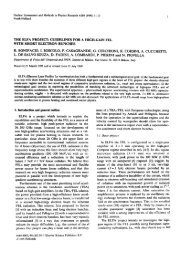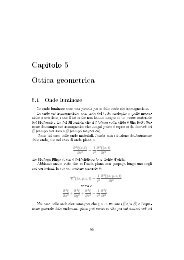Improvements of the photocathode handling systems - Infn
Improvements of the photocathode handling systems - Infn
Improvements of the photocathode handling systems - Infn
You also want an ePaper? Increase the reach of your titles
YUMPU automatically turns print PDFs into web optimized ePapers that Google loves.
EU Contract Number RII3-CT-2004-506008SFS Note-2007-001-PITZIndexIndex .................................................................................................................................................... 2Introduction ......................................................................................................................................... 31 The carrier “role” in <strong>the</strong> <strong>photocathode</strong>s experimental set-up .................................................... 31.1 The carrier ............................................................................................................................... 31.2 The preparation system ......................................................................................................... 61.3 The transport system ............................................................................................................. 91.4 The transfer system .............................................................................................................. 112 History <strong>of</strong> cathode <strong>handling</strong> improvements .............................................................................. 122.1 The carrier history: from 1 th to 3 rd generation .................................................................... 122.2 The new carrier: <strong>the</strong> 4 th generation ..................................................................................... 142.3 Improvement <strong>of</strong> <strong>the</strong> carrier movement reliability ............................................................... 162.3.1 Plugs/cathodes <strong>handling</strong> .............................................................................................. 162.3.2 Carrier <strong>handling</strong> ........................................................................................................... 183 Conclusions ................................................................................................................................. 214 Acknowledgements ..................................................................................................................... 215 References ................................................................................................................................... 21
EU Contract Number UE-RII3-CT-2007-506008 IA-SFSSFS Note xxx-2007IntroductionThe <strong>photocathode</strong> <strong>handling</strong> system has a significant impact on <strong>the</strong> <strong>photocathode</strong> lifetime duringboth its production and its usage in <strong>the</strong> RF guns. The main requests for <strong>the</strong> cathode <strong>handling</strong> are:• to be a reliable system (to guarantee safe movements <strong>of</strong> plugs/cathodes in <strong>the</strong> various<strong>systems</strong>),• to be UHV compatible (to ensure <strong>the</strong> UHV condition in <strong>the</strong> environment necessary for <strong>the</strong>cathode life and low particles production in <strong>the</strong> <strong>systems</strong>),• to be an “easy” system (to allow cathode movements also when an operator is alone),• to be compatible with different <strong>systems</strong> (preparation, transportation/storing, transferring andusage in <strong>the</strong> RF guns, etc).In this report, a short overview <strong>of</strong> <strong>the</strong> <strong>photocathode</strong> system and a description <strong>of</strong> <strong>the</strong> carrier mainfeatures are presented in section 1. In section 2, <strong>the</strong> carriers evolution, <strong>the</strong> design <strong>of</strong> <strong>the</strong> newcarrier (4 th generation) nowadays on testing and <strong>the</strong> improvement related to carrier movement andsafe cathode <strong>handling</strong> are discussed.1 The carrier “role” in <strong>the</strong> <strong>photocathode</strong>s experimental set-upThe experimental set-up relative to <strong>photocathode</strong>s is composed by “fixed” <strong>systems</strong>, installed inseveral laboratories, and by “movable” devices for <strong>the</strong> <strong>photocathode</strong>s shipment and storage inUHV condition, necessary for <strong>the</strong> sensitivity <strong>of</strong> <strong>the</strong> photoemissive film properties to gas exposition.The “fixed” <strong>systems</strong> are installed at INFN Milano-LASA (<strong>photocathode</strong> production and diagnostic)and in <strong>the</strong> photoinjectors <strong>of</strong> several facilities (such as FLASH at Hamburg, PITZ at Zeu<strong>the</strong>n, ILCTAat FNAL) while <strong>the</strong> “movable” devices are connected to <strong>the</strong> <strong>systems</strong> only for limited periods. Themovable device contains a cathode carrier that holds up to five plugs. A magnetic manipulatormoves <strong>the</strong> carrier between <strong>the</strong> movable device and <strong>the</strong> <strong>systems</strong>.The carrier has been developed to be totally compatible with <strong>the</strong> several <strong>systems</strong> (as will bedescribed in <strong>the</strong> following sections), easy to move in all <strong>the</strong> <strong>systems</strong> and able to safely holdplugs/cathodes during all <strong>the</strong> steps <strong>of</strong> <strong>the</strong>ir life. Beside <strong>the</strong>se, fur<strong>the</strong>r cathode holder requestsconsist in realizing a reliable connection system and to ensure low particle production duringcathode <strong>handling</strong>.1.1 The carrierThe carrier is mainly composed by:1) <strong>the</strong> main body (that can hold by special plungers up to 5 cathodes)2) <strong>the</strong> sliding system (composed by sliding blocks, ball bearing holding blocks and ballbearings)3) <strong>the</strong> connection system (consisting in a so called “bayonet” whose female part is directlyscrewed to <strong>the</strong> body <strong>of</strong> <strong>the</strong> carrier)The connection between <strong>the</strong> carrier and <strong>the</strong> manipulator is realized by a bayonet like connection.The male part <strong>of</strong> <strong>the</strong> bayonet, connected to <strong>the</strong> magnetic linear drive, is inserted into its femalecounterpart mounted on <strong>the</strong> carrier. The carrier movement in all <strong>the</strong> <strong>systems</strong> is guided by specialStainless Steel rails. In this section, <strong>the</strong> main futures <strong>of</strong> <strong>the</strong> carrier, common to all <strong>the</strong> carriergenerations, are presented, whereas <strong>the</strong> peculiarities <strong>of</strong> each carrier version will be in-deepdescribed in <strong>the</strong> relative subsections (2.1 and 2.2). Only for clearness, <strong>the</strong> machined parts thathave never been changed are <strong>the</strong> connection pieces (female and male bayonet) and <strong>the</strong> plungersfor cathodes holding. The o<strong>the</strong>r items, such as <strong>the</strong> main body <strong>of</strong> <strong>the</strong> carriers toge<strong>the</strong>r with <strong>the</strong>sliding block system have been modified to ameliorate <strong>the</strong> loading/unloading <strong>of</strong> <strong>the</strong> cathodes- 3 -
EU Contract Number UE-RII3-CT-2007-506008 IA-SFSSFS Note xxx-2007during <strong>the</strong>ir usage in <strong>the</strong> RF guns and to reduce <strong>the</strong> friction during movement <strong>of</strong> <strong>the</strong> carrier in <strong>the</strong><strong>systems</strong>. Moreover, <strong>the</strong> sliding blocks and <strong>the</strong> ball bearing holding blocks have been modifiedduring years to prevent any interference <strong>of</strong> <strong>the</strong> carrier movement in <strong>the</strong> valve sections. As anexample, in Fig. 1 <strong>the</strong> technical drawing <strong>of</strong> <strong>the</strong> carrier <strong>of</strong> 3 rd generation is shown while Fig. 2 showsphotos <strong>of</strong> <strong>the</strong> carrier and <strong>of</strong> its components (disassembled on <strong>the</strong> left, mounted on <strong>the</strong> right).Fig. 1. Technical drawing <strong>of</strong> 3 rd generation carrier.Fig. 2. Carrier <strong>of</strong> 3 rd generation. Left: carrier main body and components before <strong>the</strong> assembling. Right:carrier ready to be inserted in <strong>the</strong> system.The main body <strong>of</strong> <strong>the</strong> carrier realized in AISI 316L (see balloon “1” in Fig. 1), can hold up to 5cathodes (see Fig. 3). Each cathode is inserted in <strong>the</strong> hole and maintained in position by threeplungers (see balloon “8”, Fig. 1) furnished by HALDER [1] with a specific modification for UHV.Fig. 3. Technical drawing <strong>of</strong> a Molybdenum plug.- 4 -
EU Contract Number UE-RII3-CT-2007-506008 IA-SFSSFS Note xxx-2007The plunger spheres push on <strong>the</strong> dedicated 90° angle groove machined on <strong>the</strong> plug. A detaileddrawing <strong>of</strong> <strong>the</strong> plunger is shown on <strong>the</strong> bottom <strong>of</strong> Fig. 4.d 1 = M 4d 2 = 2.5 mml = 9 mms = 0.8 mmF 1 = 8.5 NF 2 = 14.0 Nmaterial: AISI 304Fig. 4. Up: photos <strong>of</strong> a cut plunger with its components, clean plungers and <strong>of</strong> <strong>the</strong> plunger cleaning devices(right). Bottom: technical drawing <strong>of</strong> <strong>the</strong> plunger (HALDER, Model: EH 2205.404) with related dimensions.Due to <strong>the</strong> UHV condition necessary for <strong>the</strong> <strong>photocathode</strong>, all <strong>the</strong> carrier components have to becleaned before <strong>the</strong>ir usage in <strong>the</strong> system. In particular, a special device has been designed andmachined for <strong>the</strong> plunger cleaning. Photos <strong>of</strong> <strong>the</strong> plunger and <strong>of</strong> <strong>the</strong> cleaning devices are shown inFig. 4 (center and right side respectively).The strength necessary to hold <strong>the</strong> plugs and to easily allow <strong>the</strong>ir insertion/extraction is adjustedregulating <strong>the</strong> three related plungers, and tightening <strong>the</strong>ir nuts. The plugs, see Fig. 3, are machinedfrom Mo rods [2] and, after surface treatment (optical polishing, BCP, standard cleaning, etc.) areinserted in <strong>the</strong> carrier holes (see Fig. 5).Fig. 5. Left: Mo plugs before and after optical polishing. Right: plugs inserted in <strong>the</strong> carrier.The movement <strong>of</strong> <strong>the</strong> carriers in all <strong>the</strong> <strong>systems</strong> is realized connecting <strong>the</strong> carrier to <strong>the</strong> magneticdriver by a bayonet-like connection. The female part on <strong>the</strong> carrier (see balloons “2” <strong>of</strong> Fig. 1) hosts<strong>the</strong> male part connected to <strong>the</strong> manipulator. The male part <strong>of</strong> <strong>the</strong> bayonet has a pin that, properlyrotated, allows <strong>the</strong> locking <strong>of</strong> <strong>the</strong> male and female part <strong>of</strong> <strong>the</strong> bayonet. The male part also has aspring to exert <strong>the</strong> necessary force to prevent <strong>the</strong> unlocking <strong>of</strong> <strong>the</strong> components. Left side <strong>of</strong> Fig. 6shows a photo <strong>of</strong> <strong>the</strong> female bayonet section connected to <strong>the</strong> carrier, on <strong>the</strong> right side <strong>the</strong> malebayonet item connected to <strong>the</strong> magnetic linear manipulator.- 5 -
EU Contract Number UE-RII3-CT-2007-506008 IA-SFSSFS Note xxx-2007Fig. 6. Left: photo <strong>of</strong> <strong>the</strong> female bayonet component, connected to <strong>the</strong> carrier main body. Right: photo <strong>of</strong> <strong>the</strong>male bayonet section, connected to <strong>the</strong> magnetic linear driver.The carrier moves in <strong>the</strong> SS rails guided by suited sliding elements, equipped with eight ballbearings, connected to <strong>the</strong> carrier main body. Besides allowing <strong>the</strong> sliding, <strong>the</strong> AISI 304 rails (seefollowing sections for <strong>the</strong> rail specifications) are <strong>the</strong> reference for <strong>the</strong> alignment <strong>of</strong> <strong>the</strong> carrierrespect to all <strong>the</strong> <strong>systems</strong>. The lower sliding blocks, equipped by ball bearings, are typicallymachined using Cu-Be (see balloons “13”, “14” and “15”, Fig. 1) while <strong>the</strong> upper ball bearingholding blocks are machined in AISI 316 (see balloon “11”, Fig. 1). The latter are also equippedwith ball bearings (see balloon “4, 5 and 6”, Fig. 1) to ensure a low friction movement <strong>of</strong> <strong>the</strong> carrierin <strong>the</strong> <strong>systems</strong>.Before <strong>the</strong> insertion <strong>of</strong> <strong>the</strong> carrier in <strong>the</strong> system, <strong>the</strong> lower sliding blocks are aligned leaning <strong>the</strong>carrier on a reference guide (see Fig. 7) and <strong>the</strong>ir positions is <strong>the</strong>n fixed by tightening screws (seeballoon “10”, Fig. 1). To improve <strong>the</strong> blocks alignment, <strong>the</strong> 4 th carrier generation has beenequipped with regulating screws for a better, easier and more reliable adjustment.Fig. 7. Photo <strong>of</strong> <strong>the</strong> special guide used for <strong>the</strong> carrier sliding blocks alignment.1.2 The preparation systemThe technical drawing <strong>of</strong> <strong>the</strong> preparation system is shown in Fig. 8. Starting from <strong>the</strong> left <strong>of</strong> <strong>the</strong> Fig.8, we have <strong>the</strong> preparation chamber (in which <strong>the</strong> evaporation process on Mo plugs is done to- 6 -
EU Contract Number UE-RII3-CT-2007-506008 IA-SFSSFS Note xxx-2007grow <strong>the</strong> photoemissive layer), <strong>the</strong> cross connection chamber (used for <strong>the</strong> connection <strong>of</strong> <strong>the</strong>transport box to <strong>the</strong> preparation chamber), <strong>the</strong> transport box (in which <strong>the</strong> carrier is loaded).Fig. 8. Technical drawing <strong>of</strong> <strong>the</strong> preparation system.After <strong>the</strong> usual cleaning and polishing treatments [2], Mo plugs are inserted in <strong>the</strong> carrier holes andmoved, by <strong>the</strong> linear drive manipulator, into <strong>the</strong> preparation chamber for <strong>the</strong> <strong>photocathode</strong>production. More in detail, after <strong>the</strong> plugs loading, <strong>the</strong> carrier is inserted in <strong>the</strong> transport box (seeparagraph 1.3) that is connected to <strong>the</strong> preparation system through an intermediate piece (crossconnection piece). In Fig. 9 <strong>the</strong> insertion <strong>of</strong> <strong>the</strong> carrier in <strong>the</strong> transport box is shown.Fig. 9. The carrier loading procedure.The carrier <strong>the</strong>n moves in <strong>the</strong> SS guides, welded to all <strong>the</strong> sections <strong>of</strong> <strong>the</strong> system in <strong>the</strong> main axisdirection, sliding with <strong>the</strong> lower sliding blocks and keeping <strong>the</strong> correct orientation thanks to <strong>the</strong>upper ball bearing holding blocks. To guarantee <strong>the</strong> correct movement, all <strong>the</strong> sections <strong>of</strong> <strong>the</strong>system are equipped with rail guides, mounted in <strong>the</strong> upper and lower side, and <strong>the</strong> lower slidingblocks have been designed to fit <strong>the</strong> guide shape, also taking into account <strong>the</strong> various interruptions- 7 -
EU Contract Number UE-RII3-CT-2007-506008 IA-SFSSFS Note xxx-2007due to <strong>the</strong> presence <strong>of</strong> UHV all metal valves between <strong>the</strong> three main sections. At least two <strong>of</strong> <strong>the</strong>three lower ball bearings must stay in contact with <strong>the</strong> guides during <strong>the</strong> carrier movement, while<strong>the</strong> upper ball bearing holding blocks in <strong>the</strong> corresponding guide keep <strong>the</strong> right orientation <strong>of</strong> <strong>the</strong>carrier (avoiding carrier rotation respect to <strong>the</strong> main axis <strong>of</strong> <strong>the</strong> system). With <strong>the</strong>se constrains, <strong>the</strong>carrier safely moves all along <strong>the</strong> carrier path not turning and keeping <strong>the</strong> correct position <strong>the</strong>cathodes. The choice <strong>of</strong> CuBe for <strong>the</strong> sliding blocks is due to <strong>the</strong> need to lower <strong>the</strong> friction between<strong>the</strong> guides and <strong>the</strong> carrier itself. A detailed description <strong>of</strong> <strong>the</strong> sliding blocks and <strong>of</strong> <strong>the</strong> ball bearingsused in all <strong>the</strong> carrier generation types is discussed in paragraphs 2.1 and 2.2.A significant use <strong>of</strong> <strong>the</strong> carrier in <strong>the</strong> preparation chamber is during <strong>the</strong> heating and evaporationprocesses <strong>of</strong> <strong>the</strong> plugs. Before <strong>the</strong> evaporation procedure starts, <strong>the</strong> plug to be treated is movedwith <strong>the</strong> carrier towards <strong>the</strong> preparation chamber where it is removed from <strong>the</strong> carrier by an AISI316L pincer. The pincer, see Fig. 10, moves perpendicularly with respect to <strong>the</strong> carrier directionand its shape has been designed to match <strong>the</strong> back pr<strong>of</strong>ile <strong>of</strong> plugs hold in <strong>the</strong> carrier. When <strong>the</strong>pincer is in <strong>the</strong> right position, <strong>the</strong> plugs on <strong>the</strong> carrier can be moved through it giving <strong>the</strong> possibilityto choose <strong>the</strong> needed plug for heating or growing treatments. Once <strong>the</strong> proper cathode has beenchosen, <strong>the</strong> pincer removes it from <strong>the</strong> carrier. A pair <strong>of</strong> balls (ceramic or ruby), pressed by aTungsten spring (see Fig. 10), keep <strong>the</strong> cathode in position within <strong>the</strong> pincer. All <strong>the</strong>se movementsare possible due to <strong>the</strong> tolerance between <strong>the</strong> plug and <strong>the</strong> pincer as well as to <strong>the</strong> carrieralignment.Fig. 10. Photos and drawings <strong>of</strong> <strong>the</strong> pincer in <strong>the</strong> preparation system. On <strong>the</strong> right, particular <strong>of</strong> <strong>the</strong> Tungstenspring.Ano<strong>the</strong>r feature <strong>of</strong> <strong>the</strong> cathode carrier is its fastening in <strong>the</strong> transport box during transportation.Typically, for safety reason related both to mechanic and vacuum requirements, when <strong>the</strong> carrierhas not to be moved, it is fixed in <strong>the</strong> transport box and <strong>the</strong> corresponding valve is closed. Thedevice that fixes <strong>the</strong> carrier is composed by a pivot that can be inserted in <strong>the</strong> backside <strong>of</strong> <strong>the</strong> plug- 8 -
EU Contract Number UE-RII3-CT-2007-506008 IA-SFSSFS Note xxx-2007or in <strong>the</strong> first hole <strong>of</strong> <strong>the</strong> carrier (respect to <strong>the</strong> bayonet), moved by a linear drive manipulator (seeFig. 11).Fig. 11. Technical drawing <strong>of</strong> <strong>the</strong> pivot used to fix <strong>the</strong> carrier. When <strong>the</strong> carrier is correctly fixed, <strong>the</strong> femalebayonet position does not interfere with <strong>the</strong> valve plate.In section 2.3 we will present new safety devices to properly position <strong>the</strong> carrier in <strong>the</strong> system, andwe will also discuss few accidents (only 3 in about 10 years <strong>of</strong> operation) occurred during <strong>the</strong>cathode <strong>handling</strong>.1.3 The transport systemThe transport system is <strong>the</strong> movable part <strong>of</strong> <strong>the</strong> <strong>photocathode</strong> experimental set-up and allows:1) shipments <strong>of</strong> <strong>photocathode</strong>s between all <strong>the</strong> laboratories2) storing <strong>of</strong> different cathodes• <strong>photocathode</strong>s (Cs 2 Te, KCsTe)• Mo cathodes (used during <strong>the</strong> gun conditioning)• scintillators (used for laser alignment purpose)3) diagnostic <strong>of</strong> <strong>the</strong> cathode properties• photo <strong>of</strong> <strong>the</strong> uncoated (Mo) and coated cathodesand only for <strong>the</strong> photoemissive films:• QE maps (also at different wavelengths)• spectral response at different wavelengths.All <strong>the</strong>se functions are carried out keeping <strong>the</strong> required UHV conditions for <strong>the</strong> <strong>photocathode</strong>lifetime, not only when <strong>the</strong> transport box is connected to <strong>the</strong> main <strong>systems</strong> but also when it istraveling between <strong>the</strong> labs. During its shipment, <strong>the</strong> box is closed by an all metal valve and <strong>the</strong>UHV condition is guarantee by a 60 l/s diode ion pump, powered by a portable HV supply.Moreover, on <strong>the</strong> “air” side <strong>of</strong> <strong>the</strong> all metal valve we keep vacuum conditions to prevent risks <strong>of</strong>contamination, gas adsorption and to reduce <strong>the</strong> force on <strong>the</strong> valve plate.Up to now we have five transport boxes that travel between <strong>the</strong> laboratories [3]. The so calledshort1 and short2 are shorter than <strong>the</strong> o<strong>the</strong>r three (Long1, Long2 and Long3) and accommodateonly <strong>the</strong> carrier <strong>of</strong> <strong>the</strong> 2 nd generation. This kind <strong>of</strong> carrier was <strong>the</strong> first type designed for <strong>the</strong> TTFfacility in 1998 and holds up to five plugs. With this carrier, <strong>the</strong> <strong>handling</strong> <strong>of</strong> <strong>the</strong> plug with fully filledcarrier required good expertise. In fact <strong>the</strong> separation <strong>of</strong> <strong>the</strong> holes for cathodes was equidistantand <strong>the</strong> <strong>handling</strong> <strong>of</strong> <strong>the</strong> plug positioned in <strong>the</strong> middle section could be done only moving <strong>the</strong> carrier- 9 -
EU Contract Number UE-RII3-CT-2007-506008 IA-SFSSFS Note xxx-2007with <strong>the</strong> pincer inserted through <strong>the</strong> o<strong>the</strong>r two previous plugs. On <strong>the</strong> contrary, with <strong>the</strong> 3 rd typecarrier (that can be used only in <strong>the</strong> longer transport boxes) <strong>the</strong> movement <strong>of</strong> plugs positioned in<strong>the</strong> center <strong>of</strong> <strong>the</strong> main body got easier thanks to <strong>the</strong> leng<strong>the</strong>ning <strong>of</strong> <strong>the</strong> carrier itself allowing forlarger spaces between <strong>the</strong> plugs. Anyhow, nowadays carrier <strong>of</strong> 2 nd and 3 rd type are still in use and<strong>the</strong> upgrade <strong>of</strong> <strong>the</strong> short boxes (leng<strong>the</strong>ning) with carrier <strong>of</strong> 3 rd or 4 th types is possible. More detailsrelative to carrier shapes are explained in paragraph 2.1.Ano<strong>the</strong>r improvement done on <strong>the</strong> transport boxes is <strong>the</strong> upgrade <strong>of</strong> a CF16 Suprasil2 viewport toa CF40 one. This viewport is used for cathodes visual inspection and diagnostic on <strong>photocathode</strong>properties. In fact <strong>the</strong> larger viewport simplify all <strong>the</strong> diagnostic procedure on <strong>photocathode</strong>s doneat LASA and also in <strong>the</strong> DESY laboratories. In Fig. 12 photos <strong>of</strong> <strong>the</strong> transport boxes are shown.Fig. 12. Left: short transport box. Right: long transport box with <strong>the</strong> lager Suprasil2 viewport.In Fig. 13 <strong>the</strong> technical drawings <strong>of</strong> <strong>the</strong> two transport box types are shown.Fig. 13. Technical drawings <strong>of</strong> <strong>the</strong> short and long transport boxes. Left: short type. Right: long type. The newCF 40 viewport is also shown (balloon “78”).- 10 -
EU Contract Number UE-RII3-CT-2007-506008 IA-SFSSFS Note xxx-20071.4 The transfer systemThe technical drawing <strong>of</strong> <strong>the</strong> transfer system installed at DESY Hamburg (for <strong>the</strong> FLASH facility) isshown in Fig. 14.Fig. 14. Technical drawing <strong>of</strong> <strong>the</strong> transfer system installed at FLASH.Starting from <strong>the</strong> right, we have <strong>the</strong> transport box, <strong>the</strong> connection cross piece and <strong>the</strong> main transferchamber. The long magnetic manipulator, as in <strong>the</strong> preparation system, moves <strong>the</strong> carrier along itsaxis. The insertion <strong>of</strong> <strong>the</strong> cathode in <strong>the</strong> RF gun is realized in <strong>the</strong> perpendicular direction using aHuntington magnetic coupled manipulator (VFS 1690-24R). The carrier is positioned in <strong>the</strong> mainexchange chamber and a CuBe pincer (similar to <strong>the</strong> one used in <strong>the</strong> preparation system),connected to <strong>the</strong> Huntington manipulator, moves <strong>the</strong> <strong>photocathode</strong> from <strong>the</strong> carrier to <strong>the</strong> RF gun.Before <strong>the</strong> <strong>photocathode</strong> insertion, <strong>the</strong> carrier is moved back in <strong>the</strong> transport box where it is fixedby <strong>the</strong> pivot (see Fig. 11). After <strong>the</strong> disconnection <strong>of</strong> <strong>the</strong> bayonet, <strong>the</strong> long manipulator is movedback to <strong>the</strong> main exchange chamber and <strong>the</strong> insertion <strong>of</strong> <strong>the</strong> cathode in <strong>the</strong> RF gun is possible.In Fig. 15 <strong>the</strong> photo <strong>of</strong> <strong>the</strong> transfer system for FLASH, assembled and tested at LASA, is shown.- 11 -
EU Contract Number UE-RII3-CT-2007-506008 IA-SFSSFS Note xxx-2007Fig. 15. Photo <strong>of</strong> <strong>the</strong> transfer system installed at FLASH.In 2001, a new system has been installed also at Zeu<strong>the</strong>n for <strong>the</strong> PITZ facility.2 History <strong>of</strong> cathode <strong>handling</strong> improvements2.1 The carrier history: from 1 th to 3 rd generationAs discussed in <strong>the</strong> introduction, <strong>the</strong> main characteristics that a cathode carrier must ensure are: tobe a safety system (avoid accident), easy to deal with (movement <strong>of</strong> <strong>the</strong> cathodes in several<strong>systems</strong> realized also by a single operator), clean one (avoid dust production), compatible to all<strong>systems</strong> (to allow cathode insertions in all <strong>the</strong> system to be produced, used, analyzed, etc.).To achieve <strong>the</strong>se main futures, <strong>the</strong> carrier has been improved in <strong>the</strong> past years to accomplish all<strong>the</strong> listed requests.The 1 st carrier generation was realized for <strong>the</strong> A0 injector at FNAL, starting from 1997 [4]. In Fig. 16<strong>the</strong> technical drawing <strong>of</strong> <strong>the</strong> carrier is shown.Fig. 16. Technical drawing <strong>of</strong> <strong>the</strong> 1 st generation carrier for A0 injector at FNAL.The main difference between this carrier and all <strong>the</strong> o<strong>the</strong>rs is that it is specific to this system, nothaving <strong>the</strong> bayonet and hence <strong>the</strong> possibility to be disconnected from <strong>the</strong> system itself. As a matter- 12 -
EU Contract Number UE-RII3-CT-2007-506008 IA-SFSSFS Note xxx-2007<strong>of</strong> fact, this carrier was conceptually designed for <strong>the</strong> FNAL closed system, composed by <strong>the</strong>preparation and <strong>the</strong> exchanging chambers directly connected to <strong>the</strong> A0 photoinjector RF gun. Theaim <strong>of</strong> this carrier was to move cathodes from <strong>the</strong> production system to <strong>the</strong> exchanging system in<strong>the</strong> RF gun. In this closed system, <strong>the</strong> plugs are always <strong>the</strong> same and cathodes can be old onesrejuvenated or <strong>the</strong>rmally destroyed. In this case, a new evaporation is done for growing <strong>the</strong> Cs 2 Tefilm. Anyhow, this carrier has been a test-stand for <strong>the</strong> following developments and improvementsrelative to all <strong>the</strong> carrier main items (i.e. <strong>the</strong> necessity to have male/female connection between <strong>the</strong>carrier and <strong>the</strong> linear manipulator, <strong>the</strong> guides shape, <strong>the</strong> sliding block materials, etc.).The next step has been <strong>the</strong> production <strong>of</strong> new carriers (2 nd and 3 rd generation) able to moveplugs/cathodes between each section <strong>of</strong> <strong>the</strong> <strong>photocathode</strong> system. These carriers, still in use in all<strong>the</strong> facilities (LASA, at DESY Hamburg for FLASH and at DESY Zeu<strong>the</strong>n for PITZ) since 1998, areshown in Fig. 17 and in Fig. 18.Fig. 17. 2 nd generation carrier.- 13 -
EU Contract Number UE-RII3-CT-2007-506008 IA-SFSSFS Note xxx-2007Fig. 18. 3 st generation carrier.The 2 nd generation carrier presents a main body similar to <strong>the</strong> 1 st generation one (5 close holes),with <strong>the</strong> exception <strong>of</strong> <strong>the</strong> bayonet side that has been designed to be connected to <strong>the</strong> magneticmanipulator. The o<strong>the</strong>r difference respect to <strong>the</strong> 1 st type, are <strong>the</strong> lower sliding blocks shapes,designed to be compatible to <strong>the</strong> SS guide interruptions (due to <strong>the</strong> UHV valves).The main difference between <strong>the</strong> 2 nd and <strong>the</strong> 3 rd generation is <strong>the</strong> main body and lower slidingblocks geometry. The leng<strong>the</strong>ning <strong>of</strong> <strong>the</strong> carrier body has been done to make easier <strong>the</strong>plug/cathode insertion and removing from <strong>the</strong> carrier. As a consequence, <strong>the</strong> transport box has tobe leng<strong>the</strong>ned to accommodate <strong>the</strong> new carrier. Fur<strong>the</strong>rmore, also <strong>the</strong> lower sliding blocks havebeen changed to fit <strong>the</strong> new dimensions.2.2 The new carrier: <strong>the</strong> 4 th generationWe started to develop it two years ago and a first prototype has been manufactured for testingpurpose. After some preliminary checks, this first version was modified, changing <strong>the</strong> length <strong>of</strong> <strong>the</strong>lower sliding blocks, to better fit <strong>the</strong> guide interruptions.In Fig. 19 and Fig. 20 <strong>the</strong> drawings <strong>of</strong> <strong>the</strong> last version <strong>of</strong> <strong>the</strong> 4 th generation carrier are shown.Comparing this design to <strong>the</strong> previous ones, it is evident that <strong>the</strong> connection pieces to <strong>the</strong>manipulator are <strong>the</strong> same, while <strong>the</strong> sliding sections have been totally modified. The main bodyshows <strong>the</strong> same geometry used for <strong>the</strong> 3 rd type, mounted with <strong>the</strong> connection <strong>of</strong> <strong>the</strong> sliding blocksreverse up/down. As a consequence, <strong>the</strong> main body is machined (for <strong>the</strong> cathode insertion) on <strong>the</strong>opposite side respect to <strong>the</strong> original 3 rd carrier type, to allow <strong>the</strong> cathode movements.- 14 -
EU Contract Number UE-RII3-CT-2007-506008 IA-SFSSFS Note xxx-2007Fig. 19. Technical drawing <strong>of</strong> <strong>the</strong> 4 st generation carrier. On <strong>the</strong> right-up, <strong>the</strong> new ball bearing.Fig. 20. Technical drawing <strong>of</strong> <strong>the</strong> 4 st generation carrier: 3D view.The driving idea <strong>of</strong> this new design is to avoid any contact between <strong>the</strong> sliding blocks and <strong>the</strong> SSguides, to limit <strong>the</strong> dust production. The goal has been achieved modifying all <strong>the</strong> sliding system,substituting <strong>the</strong> lower sliding blocks with two new ball bearing holding blocks and also modifying<strong>the</strong> upper ball bearing holding blocks shapes (all realized in AISI 316). Moreover, <strong>the</strong> new ballbearing holding blocks have been designed to be able to lodge more ball bearings positioned in all<strong>the</strong> directions to prevent any possible friction between <strong>the</strong> sliding elements and <strong>the</strong> SS guides. Asshown in <strong>the</strong> drawings, <strong>the</strong> number <strong>of</strong> ball bearings has been increased, from 8 for <strong>the</strong> 2 nd and 3 rdtype to 18, also enlarging <strong>the</strong>ir dimensions.Ano<strong>the</strong>r improvement is <strong>the</strong> amelioration <strong>of</strong> <strong>the</strong> alignment procedure. As explained before, a criticalaspect relative to all <strong>the</strong> previous carriers is <strong>the</strong> alignment <strong>of</strong> <strong>the</strong> sliding elements respect to <strong>the</strong>carrier body due to <strong>the</strong> lack <strong>of</strong> regulating screws. On <strong>the</strong> contrary, <strong>the</strong> new carrier has beenequipped by two regulating screws that simplify <strong>the</strong> procedure (see balloon “14”, “15” and “16”).In Fig. 21 photos <strong>of</strong> <strong>the</strong> 4 th generation carrier are shown.- 15 -
EU Contract Number UE-RII3-CT-2007-506008 IA-SFSSFS Note xxx-2007Fig. 21. Photo <strong>of</strong> <strong>the</strong> 4 th carrier type prototype. On <strong>the</strong> bottom right, <strong>the</strong> regulating screws for <strong>the</strong> lower ballbearing holding blocks alignment.2.3 Improvement <strong>of</strong> <strong>the</strong> carrier movement reliabilityTo ameliorate several aspects <strong>of</strong> <strong>the</strong> cathode carrier, improvements both on carrier components(material, design, etc.) and on its movement reliability have been done in <strong>the</strong> past and for <strong>the</strong>future new strategies are now under studying.The improvements have been done based on <strong>the</strong> experience gained during <strong>the</strong> intensive usage <strong>of</strong><strong>the</strong> carrier both at LASA and in <strong>the</strong> o<strong>the</strong>r laboratories, analyzing possible damages on cathodes,on <strong>the</strong>ir surface or border due to <strong>the</strong> <strong>handling</strong> and usage in <strong>the</strong> RF guns, and criticallyunderstanding <strong>the</strong> three accidents occurred at FLASH and at PITZ.2.3.1 Plugs/cathodes <strong>handling</strong>We distinguish between plug and cathode, being <strong>the</strong> former <strong>the</strong> bare Mo support for <strong>the</strong> cathode,while <strong>the</strong> latter mainly <strong>the</strong> plug with deposited photoemissive film (also Mo plugs withoutphotoemissive coating are considered cathodes after <strong>the</strong>ir heating treatments, in <strong>the</strong> preparation- 16 -
EU Contract Number UE-RII3-CT-2007-506008 IA-SFSSFS Note xxx-2007system, and <strong>the</strong>ir shipment) [2]. Plug <strong>handling</strong> happens during <strong>the</strong> typical first treatments <strong>of</strong> <strong>the</strong><strong>photocathode</strong> growing process, such as <strong>the</strong> heating treatment (for cleaning) and <strong>the</strong> depositionprocess (<strong>the</strong> plug is inserted in <strong>the</strong> round shaped masking for <strong>the</strong> evaporation [5]). Cathode<strong>handling</strong> involves <strong>the</strong> main part <strong>of</strong> <strong>the</strong> <strong>photocathode</strong> life starting from <strong>the</strong> diagnostic on newcathodes (during <strong>the</strong> production and in <strong>the</strong> transport box just after <strong>the</strong> production), <strong>the</strong>ir storing andshipment in <strong>the</strong> transport box, <strong>the</strong>ir usage in <strong>the</strong> RF guns (connection with <strong>the</strong> transfer system andinsertion in <strong>the</strong> RF gun), <strong>the</strong>ir shipment towards LASA for post-usage analysis.From this introduction, it is clear that not only <strong>the</strong> carrier movements but also <strong>the</strong> plug/cathodemovements are important for <strong>the</strong>ir safety and low dust production.The first improvement, as mentioned before, was a redesign <strong>of</strong> <strong>the</strong> carrier shape, in particularameliorating <strong>the</strong> holes position (wider distances) facilitating plugs/cathodes catching.Moreover, from <strong>the</strong> experiences gained during about 10 years <strong>of</strong> <strong>photocathode</strong> production andusage, and thanks to periodical checks on <strong>the</strong> surface and border <strong>of</strong> used cathodes, we haveobserved that one critical point that can be a dust source in <strong>the</strong> system are frictions on <strong>the</strong> Mo plugsides that causes visible scratches, as shown in Fig. 22. These scratches are visible only on fewcathodes and correspond to <strong>the</strong> plungers (see Fig. 4) position. As explained before, plungers areused to fix <strong>the</strong> position <strong>of</strong> plugs in <strong>the</strong> carrier holes. A not correct balancing <strong>of</strong> <strong>the</strong> plunger positionor a not correct functioning (if ball doesn’t roll during <strong>the</strong> plug <strong>handling</strong>) increases <strong>the</strong> frictionbetween <strong>the</strong>m and <strong>the</strong> Mo plug side and might causes scratches and also dust. A properadjustment <strong>of</strong> <strong>the</strong> plungers’ position solved <strong>the</strong> problem. Typically, <strong>the</strong> plunger streng<strong>the</strong>ning iscarefully checked during <strong>the</strong> plug loading in <strong>the</strong> carrier before its insertion in <strong>the</strong> preparationsubsystem. The correct balancing is achieved trying to insert and remove <strong>the</strong> plug till optimumcondition.80.1109.1 36.147.3 60.1Fig. 22. Photos <strong>of</strong> cathodes side damages.To check <strong>the</strong> correct strength, at LASA we are now producing a suited device that will give <strong>the</strong>correct plunger position respect to <strong>the</strong> plug. The idea is to check, by an electric contact, <strong>the</strong> rightposition with respect to <strong>the</strong> cathode position.In Fig. 22 o<strong>the</strong>r kinds <strong>of</strong> damages are visible (see cathode 80.1 and cathode 47.3, as an example),not correlated to <strong>the</strong> carrier device. This kind <strong>of</strong> damages are typically burnings due to <strong>the</strong> RFcontact between <strong>the</strong> RF-contact spring (usually Cu-Be or silvered Cu-Be) and <strong>the</strong> cathode. The red- 17 -
EU Contract Number UE-RII3-CT-2007-506008 IA-SFSSFS Note xxx-2007colored material should be due to Copper coming from <strong>the</strong> spring itself or from <strong>the</strong> backplane <strong>of</strong><strong>the</strong> RF gun.Damages on <strong>the</strong> front polished surface can be due to discharges in <strong>the</strong> RF gun occurring during<strong>the</strong> conditioning procedure or also during standard operation (see as an example Mo cathode 32.2in Fig. 23). Anyhow, any dust particles located on <strong>the</strong> cathode surface can induce dischargecausing holes and craters on <strong>the</strong> surface. Sources <strong>of</strong> dust can be <strong>the</strong> friction occurring duringcathode insertion/removing both in <strong>the</strong> carrier holes and in <strong>the</strong> gun, this last due to friction between<strong>the</strong> cathode body and <strong>the</strong> RF contact spring. Referring to <strong>the</strong> second photo in Fig. 23 (taken withmicroscope), we observe a Cu particle located in <strong>the</strong> middle <strong>of</strong> <strong>the</strong> damaged coating border <strong>of</strong>cathode 11.2. Ano<strong>the</strong>r cause <strong>of</strong> damages can be an improper <strong>handling</strong> <strong>of</strong> <strong>the</strong> cathode. As anexample, in Fig. 23 (third position) a photo <strong>of</strong> a Mo cathode (53.1) is presented. Even if <strong>the</strong>sedamages are very rare, scratches on <strong>the</strong> surface (left side) are clearly visible. These kinds <strong>of</strong>damages can be a consequence <strong>of</strong> a not correct insertion <strong>of</strong> <strong>the</strong> cathode in <strong>the</strong> gun or in <strong>the</strong>cathode holder [6]. Of course, also mechanical accident can produce dust. As an example, amechanical accident occurred during <strong>the</strong> <strong>handling</strong> <strong>of</strong> cathode 37.2 at FLASH (see subsection 2.3.2for details) produced dust and contaminated <strong>the</strong> plug surface. As a consequence, <strong>the</strong>re was a verysharp increase <strong>of</strong> <strong>the</strong> measured dark current (a factor <strong>of</strong> 5 in 2 days). After this event, ano<strong>the</strong>rcesium telluride cathode (23.2) was inserted in <strong>the</strong> gun and <strong>the</strong> dark current starts to decreaseagain, even if from higher level. After about one year <strong>of</strong> continuous operation, values near to initialone were approached [6]. The last picture <strong>of</strong> Fig. 23 (on <strong>the</strong> right) a photo <strong>of</strong> <strong>the</strong> cathode 37.2 justafter <strong>the</strong> accident is shown.Fig. 23. Starting from <strong>the</strong> left, cathode 32.2 after <strong>the</strong> Gun conditioning at PITZ; Cu particle on <strong>the</strong> coatingborder <strong>of</strong> cathode 11.2; cathode 53.1 with scratches on <strong>the</strong> border; a picture <strong>of</strong> cathode 37.2 taken after <strong>the</strong>accident: near upper edge <strong>of</strong> <strong>the</strong> coating a bright particle is visible.2.3.2 Carrier <strong>handling</strong>The problem related to <strong>the</strong> carrier <strong>handling</strong> are typically due to:• a not correct alignment <strong>of</strong> its sliding components (sliding blocks)• <strong>the</strong> damage <strong>of</strong> <strong>the</strong> ball bearings• <strong>the</strong> not correct “parking” <strong>of</strong> <strong>the</strong> carrier in <strong>the</strong> systemThe consequence <strong>of</strong> <strong>the</strong> first two aspects is that dust can be produced in <strong>the</strong> system due to a notcorrect sliding <strong>of</strong> <strong>the</strong> carrier and scratches on <strong>the</strong> cathode surface due to a not precise alignment <strong>of</strong>carrier respect to <strong>the</strong> pincer. Moreover, <strong>the</strong> not correct alignment <strong>of</strong> <strong>the</strong> sliding blocks is dangerouswhen <strong>the</strong> carrier pass through <strong>the</strong> valves. In <strong>the</strong>se cases, <strong>the</strong> sliding sections might touch <strong>the</strong> body<strong>of</strong> <strong>the</strong> valve and might damage <strong>the</strong> valve body side <strong>of</strong> seal. It is also possible that <strong>the</strong> dustproduced by <strong>the</strong> friction between <strong>the</strong> sliding blocks and <strong>the</strong> rails falls onto <strong>the</strong> valve body in <strong>the</strong>region <strong>of</strong> <strong>the</strong> sealing. These accidents happened two times and for this reason we started todevelop <strong>the</strong> fourth generation carrier.The not correct sliding <strong>of</strong> <strong>the</strong> carrier in <strong>the</strong> system can be caused mainly by a not good alignment<strong>of</strong> <strong>the</strong> carrier blocks or by broken ball bearings. Just to specify, a broken ball bearing means that,for examples, it doesn’t roll. The first consequence is that we have a friction between it and <strong>the</strong>- 18 -
EU Contract Number UE-RII3-CT-2007-506008 IA-SFSSFS Note xxx-2007guiding rails. Moreover, it causes also a not correct positioning <strong>of</strong> <strong>the</strong> carrier (not parallel to <strong>the</strong>guides) that can be a problem during <strong>the</strong> insertion/removing <strong>of</strong> <strong>the</strong> cathodes with <strong>the</strong> pincer.The preventive action we take to avoid some <strong>of</strong> <strong>the</strong> problems described before is a carefulalignment <strong>of</strong> <strong>the</strong> sliding blocks and <strong>of</strong> <strong>the</strong> ball bearing holding blocks done before each carrierloading in <strong>the</strong> system (usage <strong>of</strong> <strong>the</strong> refaced guide, see Fig. 7) toge<strong>the</strong>r with a check <strong>of</strong> <strong>the</strong> ballbearing status, eventually substituting <strong>the</strong>m if broken.The correct “parking” <strong>of</strong> <strong>the</strong> carrier is one <strong>of</strong> <strong>the</strong> key points for safe carrier movements. From <strong>the</strong>experience at PITZ and at FLASH (before TTF), <strong>the</strong> only accident occurred is relative to a notcorrect <strong>handling</strong> and parking <strong>of</strong> <strong>the</strong> carrier in <strong>the</strong> transport box. At PITZ (that started operation in2001 and where <strong>the</strong> carrier movements are <strong>of</strong> <strong>the</strong> order <strong>of</strong> some hundreds), we have recorded onlytwo accidents caused by a not correct parking <strong>of</strong> <strong>the</strong> carrier. In <strong>the</strong> first accident, <strong>the</strong> carrier wasfixed by <strong>the</strong> pivot in <strong>the</strong> second carrier hole (on <strong>the</strong> bayonet side) and <strong>the</strong> bayonet was detached.The operator <strong>the</strong>n closed <strong>the</strong> all metal valve (between <strong>the</strong> transport box and <strong>the</strong> transfer system)damaging <strong>the</strong> bayonet and <strong>the</strong> valve itself. As a matter <strong>of</strong> fact, a section <strong>of</strong> <strong>the</strong> female bayonet wasin <strong>the</strong> middle <strong>of</strong> <strong>the</strong> valve and <strong>the</strong> valve metal plate closed on it. In Fig. 24 a photo with <strong>the</strong>damaged bayonet components is shown.Fig. 24. Photo <strong>of</strong> damaged components <strong>of</strong> <strong>the</strong> female bayonet after <strong>the</strong> PITZ accident.The o<strong>the</strong>r accident happened at DESY Hamburg, during <strong>the</strong> TTF phase II operation. Just toremember, this machine started to operate in 1998 (TTF phase I) and is still running (FLASH).During <strong>the</strong>se years, no accidents to <strong>the</strong> cathode carrier <strong>handling</strong> have been recorded showing <strong>the</strong>very good reliability <strong>of</strong> <strong>the</strong> system. Never<strong>the</strong>less, <strong>the</strong> only accident occurred is September 2004and it is important to analyze it to prevent future problems. In this case, <strong>the</strong> carrier movement andparking was done correctly, locking <strong>the</strong> carrier in <strong>the</strong> transport box by inserting <strong>the</strong> pivot in <strong>the</strong> firsthole (on <strong>the</strong> bayonet side). The accident occurred during <strong>the</strong> bayonet detaching. In fact <strong>the</strong>manipulator magnet decoupled from its vacuum counterpart leaving <strong>the</strong> manipulator body (rod)connected to <strong>the</strong> carrier. No feedbacks gave <strong>the</strong> possibility to <strong>the</strong> operator to know that <strong>the</strong>manipulator was still connected to <strong>the</strong> carrier (<strong>the</strong> only one would be to check by eye <strong>the</strong> presenceor not <strong>of</strong> <strong>the</strong> manipulator in <strong>the</strong> system). This means that <strong>the</strong> operator followed <strong>the</strong> usualprocedure, detaching <strong>the</strong> bayonet and moving <strong>the</strong> manipulator back in its rest position (not in <strong>the</strong>reality!). When <strong>the</strong> all metal valve was closed, it damaged <strong>the</strong> male section <strong>of</strong> <strong>the</strong> bayonet and alsoits plate. In Fig. 25 a photos <strong>of</strong> <strong>the</strong> damages are presented.- 19 -
EU Contract Number UE-RII3-CT-2007-506008 IA-SFSSFS Note xxx-2007Fig. 25. TTF phase II accident. Left: photo <strong>of</strong> damaged components <strong>of</strong> <strong>the</strong> male bayonet. Right: photo <strong>of</strong> <strong>the</strong>system.These accidents have been caused by different reasons (operator and mechanical mistake) but<strong>the</strong>ir consequences have been about <strong>the</strong> same: high costs (to repair <strong>the</strong> valve, new transport boxshipment) and stop <strong>of</strong> <strong>the</strong> machine operation (for FLASH hours <strong>of</strong> stops). Moreover, <strong>the</strong> cathodesinside <strong>the</strong> <strong>systems</strong> died (due to air exposition needed for repairing) and <strong>the</strong> movements <strong>of</strong> <strong>the</strong>carrier in case <strong>of</strong> TTF phase II accident were not possible (male bayonet and manipulatordamaged) while <strong>the</strong>y were possible in <strong>the</strong> PITZ system (changing <strong>the</strong> transport box andconsequently <strong>the</strong> carrier). We could cope with <strong>the</strong>se accidents by <strong>the</strong> availability <strong>of</strong> transport boxused as spares for <strong>the</strong> RF gun. The PITZ accident was efficiently resolved thanks to <strong>the</strong> presence<strong>of</strong> a spare box that was immediately installed.To avoid future accidents and also to improve <strong>the</strong> cathode carrier movement reliability, some newstrategies are now on study at LASA. The idea is to check <strong>the</strong> presence <strong>of</strong> <strong>the</strong> carrier (or <strong>of</strong> <strong>the</strong>manipulator body) in critical sections <strong>of</strong> <strong>the</strong> system (i.e. <strong>the</strong> exchange section between <strong>the</strong>Huntington and <strong>the</strong> VG manipulators, <strong>the</strong> valve between <strong>the</strong> transport and transfer box) collectingspecific output signals. The last solution now on study is <strong>the</strong> usage <strong>of</strong> laser position sensors,basing on <strong>the</strong> measurement <strong>of</strong> <strong>the</strong> reflectivity <strong>of</strong> specific items (as an example we have used <strong>the</strong>Cu-Be sliding blocks). In Fig. <strong>the</strong> sensor and <strong>the</strong> experimental set-up used for <strong>the</strong> preliminary testsare shown (furnished by Keyence [7]).Fig. 26. Laser position sensors on test at LASA.These items are planned to be inserted in each transport boxes and also in <strong>the</strong> transfer system. In<strong>the</strong> transport box, sensors will give information relative to <strong>the</strong> correct position <strong>of</strong> <strong>the</strong> carrier, whenlocked with <strong>the</strong> pivot. The sensor in <strong>the</strong> transfer subsystem will give information <strong>of</strong> <strong>the</strong> presence ornot <strong>of</strong> <strong>the</strong> manipulator body.- 20 -
EU Contract Number UE-RII3-CT-2007-506008 IA-SFSSFS Note xxx-20073 ConclusionsThe movement <strong>of</strong> plug/cathode in <strong>the</strong> different sections <strong>of</strong> <strong>the</strong> <strong>photocathode</strong> system is one criticalitem for <strong>the</strong> <strong>photocathode</strong> <strong>handling</strong> and lifetime. During years, <strong>the</strong> <strong>handling</strong> <strong>of</strong> cathodes has beenameliorate in all <strong>the</strong> phase <strong>of</strong> <strong>the</strong>ir life simplifying it, trying to decrease <strong>the</strong> dust production andstudying new strategies to improve its reliability. In this note, <strong>the</strong> main aspects <strong>of</strong> <strong>the</strong> experimentalset-up have been described also giving an overview <strong>of</strong> <strong>the</strong> changing occurred during years <strong>of</strong>cathode production and usage in <strong>the</strong> RF guns. Moreover, <strong>the</strong> critical analysis <strong>of</strong> <strong>the</strong> few accidentsoccurred, has been discussed to introduce <strong>the</strong> future improvement now on study.4 AcknowledgementsWe acknowledge <strong>the</strong> support <strong>of</strong> <strong>the</strong> European Community-Research Infrastructure Activityunder <strong>the</strong> FP6 “Structuring <strong>the</strong> European Research Area” program(IA-SFS, contract number UE-RII3--CT-2004-506008).5 References[1] HALDER (represented by AGINT), http://www.agint.com/.[2] P. Michelato, L. Monaco, P. Pierini, D, Sertore, “Report on Studies on PhotocathodePerformances”, SFS Internal Note, 2006.[3] Database address: http://wwwlasa.mi.infn.it/ttfcathodes/[4] A. Fry, E. Hahn, W. Hartung, M. Kuchnir, P. Michelato, D. Sertore, „Experience at Fermilabwith high quantum efficiency photo-cathodes for RF electron guns“, Linac98[5] D. Sertore, P. Michelato, L. Monaco, S. Schreiber, J. H. Han, A. Bonucci, “Review <strong>of</strong> <strong>the</strong>production process <strong>of</strong> TTF and PITZ <strong>photocathode</strong>s”, proceedings PAC2003, Portland, USA.[6] L. Monaco, P. Michelato, C. Pagani, D. Pierini, D. Sertore, J. H. Han, S. Schreiber, M.Krasilnikov, F. Stephan, “Dark current investigation <strong>of</strong> FLASH and PITZ RF guns”, Proc.EPAC2006 – WEPLS051, Edinburgh, Scotland, pp. 2493-2495, 2006.[7] http://www.keyence.com/- 21 -




